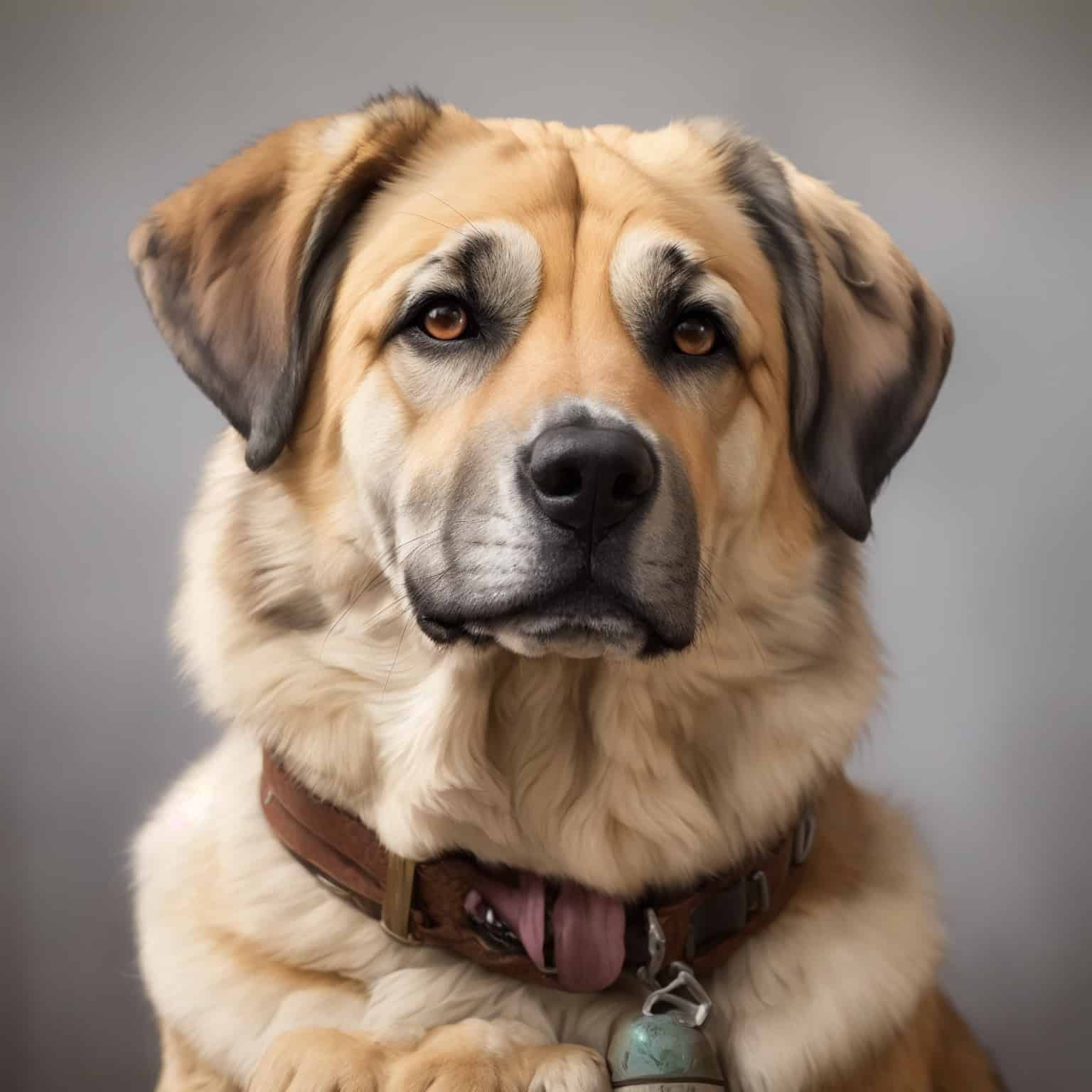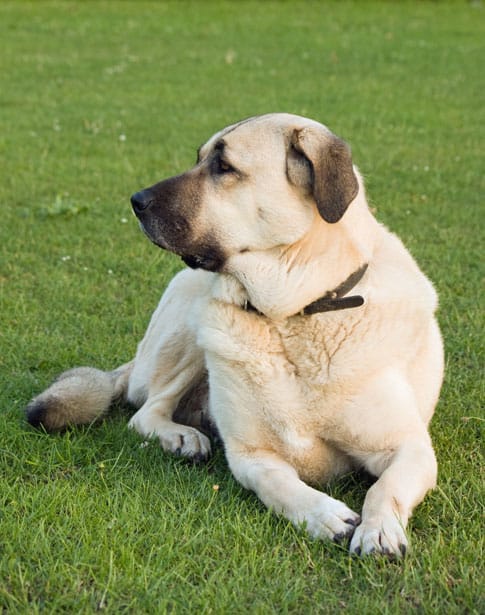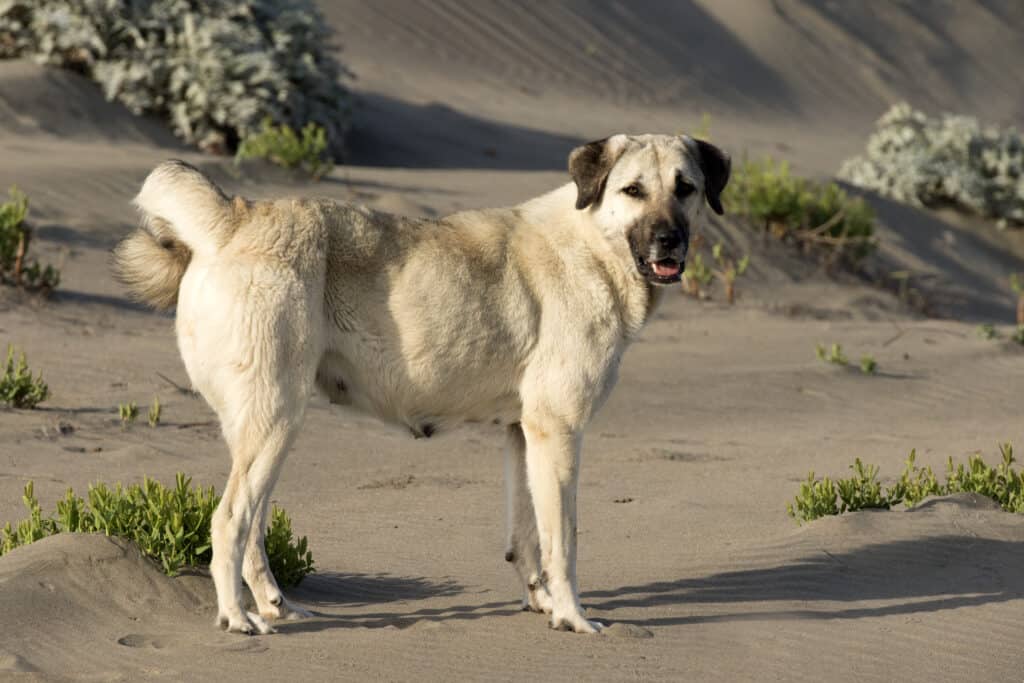The Anatolian Shepherd, an epitome of strength, unwavering loyalty, and remarkable protective instincts, has made its mark among dog enthusiasts and those seeking a dependable guardian. With a history in Anatolia, distinctive physical features, and a unique set of temperament traits, this breed is revered as a loyal and vigilant protector of home and livestock.

| Category (Explanation) | Breed Information |
|---|---|
| Year of Breed Conception | Ancient breed, exact date uncertain |
| Country of Origin | Turkey |
| Weight (lbs & kg) (Male) | 110-150 lbs (50-68 kg) |
| Weight (lbs & kg) (Female) | 80-120 lbs (36-54 kg) |
| Coat Type | Short double coat |
| Color Variations | Various colors, often with a black mask |
| Shedding Level (Low, Moderate, High) | Moderate |
| Height (cm & in) | 27-29 inches (69-74 cm) |
| Breed Size | Giant |
| Trainability (Low, Moderate, High) | Moderate |
| Mental Needs (Low, Moderate, High) | Moderate |
| Intelligence Level (Low, Moderate, High) | High |
| Energy Level (Low, Moderate, High) | Moderate |
| Agility (Low, Moderate, High) | Moderate |
| Loyalty (Low, Moderate, High) | High |
| Playfulness (Low, Moderate, High) | Low |
| Exercise Needs | Regular exercise and space to roam |
| Guarding Proficiency (Low, Moderate, High) | High |
| Sociability with Children (Low, Moderate, High) | Low |
| Barking Level (Low, Moderate, High) | Moderate |
| Digging Tendency (Low, Moderate, High) | Low |
| Destructive Behavior (Low, Moderate, High) | Low |
| Drooling Level (Low, Moderate, High) | Low |
| Obedience Level (Low, Moderate, High) | Moderate |
| Apartment Friendly (Yes/No) | Not suitable for apartment living |
| Inherent Prey Drive | Moderate |
| Physical Risk to Others (Low, Moderate, High) | Low |
| Travel Fatality Risk (Low, Moderate, High) | Low |
| Allergen Potential | Low |
| Health Concerns (List of Common Health Concerns) | Hip Dysplasia, Bloat, Entropion |
| Average Life Expectancy (Life Expectancy in Years) | 10-13 years |
Woof Mastery is reader supported and our articles may contain affiliate links.
Instead of running third party ads that we have no control of we only use links from high-quality companies we are directly partnered with. Making use of these links come at no cost to you our reader, and in many cases have the extra benefit of discounted rates or sign up bonuses.
If you’re interested you can read more about our affiliate policy here.
We appreciate your support and always insure that the products and services we recommend are high-quality, helpful and relevant to the subject at hand!
The Anatolian Shepherd’s history is a tale of guardianship and protection. These dogs originated in Turkey, where they were bred to safeguard livestock, particularly against predators like wolves and bears.
Their size and strength made them formidable protectors, and their loyalty to the herd was unwavering. They became known for their courage and vigilance in the face of threats.
Today, Anatolian Shepherds are celebrated for their protective nature and their role in preserving livestock. They are cherished for their loyalty to their human families and their dedication to their guarding duties.

The Anatolian Shepherd Dog is special for its imposing size and protective instincts. These dogs have a history of guarding livestock against formidable predators. Their loyalty and courage make them remarkable guardians and family pets.
Anatolian Shepherds have a tradition of guarding and protecting livestock in Turkey. Their size, strength, and protective instincts made them formidable guardians of herds, protecting them from predators. Today, they continue to work as livestock guardians and are treasured family protectors, preserving their heritage as dependable working dogs.
Anatolian Shepherds are celebrated for their protective and loyal personalities. They are known for their courage, independence, and guarding abilities. These dogs have a history of guarding livestock against large predators.
Their protective instincts and loyalty to their families make them dedicated protectors. Anatolian Shepherds are characterized by their courage, independence, and a strong sense of responsibility, epitomizing the perfect blend of loyalty and protection.
Anatolian Shepherds are protective and independent. They can be good with children and other pets but may be reserved with strangers. Early socialization is important to ensure a well-adjusted temperament.
They require physical exercise and a job to do to stay content.
Anatolian Shepherds are large-sized dogs with a well-proportioned and powerful build. They have a strong head with dark, oval-shaped eyes and triangular ears.
They have a short to medium-length double coat that lies close to their skin. Coat colors are often solid white, fawn, brindle, or cream. Their tail is usually long and carried low.
Males typically stand between 28 to 31 inches (71-79 cm) at the shoulder and weigh between 90 to 150 pounds (41-68 kg), while females are slightly smaller and lighter.
Anatolian Shepherds have a powerful and protective presence, reflecting their role as livestock guardians.
Anatolian Shepherds come in various coat colors, including white, cream, fawn, and brindle. They may not have distinct coat colors.
Anatolian Shepherds often have solid coat colors in white, cream, fawn, or brindle without distinct coat patterns.
Anatolian Shepherds have a moderate shedding level. They shed consistently with seasonal variations. Regular grooming and brushing are recommended to control shedding and maintain their coat.
Anatolian Shepherds have a short, dense coat that requires minimal grooming. Grooming habits for this breed include:
1. Brushing: Occasional brushing with a slicker brush is sufficient to remove loose fur and maintain coat health.
2. Bathing: Bathe Anatolian Shepherds when necessary using a dog-specific shampoo and ensure thorough rinsing.
3. Ears: Check and clean their ears regularly to prevent wax buildup or infections with a veterinarian-recommended ear cleaning solution.
4. Nails: Keep their nails trimmed to a comfortable length to maintain proper gait and prevent discomfort.
5. Teeth: Brush their teeth regularly to ensure dental health and prevent bad breath. Dental chews or toys can be beneficial.
6. Tail and Paw Care: Maintain cleanliness in the tail and paw areas, inspecting for any signs of irritation or injury.
Anatolian Shepherds have a moderate to high activity level and enjoy both physical and mental challenges. Key points about their activity level include:
1. Exercise Needs: Anatolian Shepherds require daily exercise to stay happy and healthy. Activities can include walks, playtime, and interactive activities.
2. Energy Level: They have moderate to high energy levels, especially when young. Regular exercise helps keep them content.
3. Working Heritage: Historically, Anatolian Shepherds were bred for protecting livestock. They excel in activities like obedience, agility, and guarding tasks.
4. Mental Stimulation: In addition to physical activity, mental challenges through training and problem-solving games are important to keep them mentally sharp.
5. Outdoor Companions: They enjoy outdoor activities and make excellent companions for those who enjoy hiking and running.
White Shepherds are highly intelligent dogs known for their problem-solving abilities. Here are some key points about their intelligence:
White Shepherds’ intelligence and versatility make them excel in a variety of roles. Training, socialization, and mental stimulation are vital for their development and well-being.
Anatolian Shepherds are intelligent and need mental stimulation. Engage them in obedience training and activities that challenge their minds to keep them sharp.
Social Interaction: They are social dogs and require regular interaction with their human family. Loneliness can lead to anxiety or destructive behavior, so provide companionship and attention.
Exercise: Mental exercise is equally important. Offer them tasks that challenge their problem-solving skills.
Training and Obedience: Anatolian Shepherds benefit from obedience training and activities that engage their minds. Consistent, positive-reinforcement training is effective in shaping their behavior.
Enter The Woof Mastery

Thinking about an Anatolian Shepherd? Consider these factors:
1. Activity Level: Anatolian Shepherds are active and require regular exercise and mental stimulation.
2. Training Needs: They are intelligent but can be independent, so consistent training is important.
3. Space: They need space to move around comfortably and are better suited for homes with yards.
4. Coat Care: Regular grooming is essential to manage their coat, which sheds moderately.
5. Livestock Protection: Anatolian Shepherds have a natural instinct to protect livestock, so consider your needs if you have a farm or animals.
Anatolian Shepherds have the potential to pose a physical risk to others if not properly socialized, trained, or managed. The risk assessment factors include:
1. Protective Instinct: Anatolian Shepherds have a strong protective instinct, especially towards their family and livestock. Proper training is essential to manage this instinct.
2. Socialization: Early and thorough socialization is crucial to ensure Anatolian Shepherds are comfortable around people and other animals. Poor socialization can lead to fear or aggression.
3. Training: Obedience training is essential to teach Anatolian Shepherds appropriate behavior and ensure they respond to commands. Well-trained dogs are less likely to engage in aggressive behavior.
4. Owner Responsibility: Responsible ownership involves being aware of the dog’s behavior and taking necessary precautions in public settings.
5. Breed-Specific Legislation (BSL): Anatolian Shepherds may not be commonly subject to BSL, but owners should be aware of local regulations.
6. Individual Variability: Each dog is unique, and behavior can vary. Responsible ownership, proper training, and socialization are key to minimizing the potential physical risk to others.
Anatolian Shepherds can be good with children, but their protective nature and size may require supervision and training. They are loyal and may form strong bonds with kids. Early socialization is important to ensure they are well-adjusted around children.
Anatolian Shepherds may be capable swimmers, but their preference for water activities varies. Their physical build is suitable for swimming, but not all individuals may enjoy it. Always gauge your dog’s comfort level with water and provide close supervision when they are near water.
Positive training practices will help your Anatolian Shepherd puppy become a well-behaved and loyal companion.
Anatolian Shepherds are usually moderate in terms of noisiness. They may bark to alert their owners to potential dangers or intruders. Their protective instincts can lead to occasional vocalization.
Anatolian Shepherds thrive in homes that provide:
Challenges:
When traveling with Anatolian Shepherds, consider the following:
Anatolian Shepherds are generally healthy, but they may be prone to certain health concerns, including:
Proper nutrition is essential for Anatolian Shepherds. Follow these nutritional habits:
Proper nutrition is essential for the health and well-being of Anatolian Shepherds.
Breed-specific laws (BSL) may affect Anatolian Shepherds in certain areas, and owners should be aware of these regulations. BSL is typically enacted at the local level, and the restrictions can vary from one jurisdiction to another. Here are some common types of BSL restrictions that Anatolian Shepherds may encounter:
The rationale for BSL is often based on concerns about public safety and perceived risks associated with specific breeds, including Anatolian Shepherds. However, it’s important to note that Anatolian Shepherds are not inherently aggressive, and BSL may affect them due to their physical resemblance to breeds sometimes included in these laws.
BSL is a contentious subject, and many advocates argue that it unfairly targets breeds rather than addressing individual dog behavior. They emphasize that responsible ownership, training, and education should be emphasized instead of breed-specific restrictions.
To determine if there are breed-specific laws or restrictions regarding Anatolian Shepherds in your area, you should check with your local animal control or government authorities. Be aware of and comply with any local regulations to ensure that you are in compliance with the law while owning an Anatolian Shepherd.
Woof Mastery is reader supported and our articles may contain affiliate links.
Instead of running third party ads that we have no control of we only use links from high-quality companies we are directly partnered with. Making use of these links come at no cost to you our reader, and in many cases have the extra benefit of discounted rates or sign up bonuses.
If you’re interested you can read more about our affiliate policy here.
We appreciate your support and always insure that the products and services we recommend are high-quality, helpful and relevant to the subject at hand!
Myth 1: Anatolian Shepherds are Not Good with Families
Truth: Anatolian Shepherds can be excellent family dogs. They are protective and loyal, but they require proper socialization and supervision around children.
Myth 2: They are Aggressive by Nature
Truth: While they have a protective nature, Anatolian Shepherds are not inherently aggressive. Proper training and socialization are important for their behavior.
Anatolian Shepherds, known for their protective instincts and loyalty, may not have as many widely recognized famous individuals. They excel in their traditional role as livestock guardians, protecting herds from predators and threats.
Anatolian Shepherds have a long history as livestock guardians. While specific historical owners may not be widely documented, these dogs have played a vital role in protecting livestock in their native regions.
Anatolian Shepherds, like all breeds, face certain challenges and dangers. Some of the greatest dangers and concerns for the breed include:
By understanding these challenges and providing responsible ownership and care, many of these dangers can be mitigated to ensure the well-being of Anatolian Shepherds.
The Anatolian Shepherd is an ancient breed that originated in Turkey. It was bred by nomadic shepherds to protect livestock from predators. The breed’s development involved local herding and guardian dogs, selected for their protective instincts and size.
The Anatolian Shepherd, known for its strength and protective instincts, is a breed that excels in guarding roles. Their devoted nature and imposing presence have made them valuable working dogs and companions.
Owning an Anatolian Shepherd entails providing mental and physical stimulation, grooming, and regular veterinary care. Responsible ownership includes addressing potential health concerns and nurturing their protective instincts through training.
With their sturdy build and unwavering loyalty, Anatolian Shepherds continue to make a significant impact in the lives of those who appreciate their protective instincts and companionship.